(Editor’s note: There’s been talk in racing media about bringing North Wilkesboro Speedway back to life. Earlier this week I even saw that the SRX-Series was interested in going racing there, so I thought I bring back this one from our friend PattyKay Lilley.)
I bid you welcome gentle readers, and a warm and cordial “Howdy” to our assigned reader of all things NASCAR. Today when visiting our editing pages, which I do every morning, I noticed something in the “search” list that was different from the usual casual or general search terms. (I’ve never asked who provides them, but I assume the stats come either from Google or our Web host, Weebly. Likely the latter, because we pay them.) Someone had visited our pages seeking “History of North Wilkesboro.” That’s an arena quite familiar to this scribe, as we visited and enjoyed the hospitality of that Grand Old Lady and the town that she calls home several times before she saw her reign as NASCAR’s oldest track from the original schedule come to its sad end.
Wednesday, September 29, 2021 will mark 25 years since the last race was run at North Wilkesboro Speedway. Please join me in recalling some of what was North Wilkesboro, and probably a generous sprinkling of my own opinion on the way she met her demise. As you continue to read, remember this picture…

There was a time in NASCAR’s history when the month of April was short track month, consisting of races at Bristol, Tennessee, Martinsville, Virginia and North Wilkesboro, North Carolina, with the fourth weekend usually giving way to Easter festivities. Of course, North Wilkesboro is no longer found anywhere on the schedule. She sits languishing through season after season as Mother Earth works to reclaim what once was the grandeur of one of NASCAR’s inaugural racing venues.
In the Brushy Mountains of Northern North Carolina, along US 421, one finds the small town of North Wilkesboro, which I’ve heard described by one resident as “Our little piece of heaven.” Of course, that was back in the days when there was a racetrack operating four miles east of the little town. With two dates each year on the Winston Cup schedule, it provided much of the economy that kept the town solvent. The racetrack is still there, but the engines no longer roar to life twice a year; storied heroes of NASCAR’s Cup ranks no longer race on its .625-mile of asphalt and of course, the thousands of fans for whom the town rolled out the red carpet no longer come.

It was way back in 1947, before the birth of NASCAR, that Enoch Staley finished building his little dirt bullring, and it was ready and waiting to become one of the original tracks to host several races run by NASCAR’s new “Modified” division in 1948 and a “Strictly Stock” race in 1949. In 1957, wanting to keep abreast of the times, Staley dressed his little lady in asphalt. I’m not sure if it were intentional or merely the least expensive way to do it, but the track became unique in that rather than being level, one drove uphill on the backstretch and downhill on the front stretch, giving it the feel of a small road course with all left turns. The drivers loved it when they came through 400 revolutions unscathed, and still managed to love it when some fellow competitor summarily removed them from the race with a front bumper. It was a short track in the finest tradition of the Southeast, presenting a stiff challenge and delivering all sorts of bragging rights for the conquering heroes.
Although Staley built it, North Wilkesboro has long been known as “Junior’s House” or “The House that Junior Built.” That refers to the legendary Junior Johnson, who enjoyed marked success both as a driver and as a car owner on the little track that was built almost in his back yard. If one is familiar with the driving style employed by Johnson, it’s not surprising that he would excel at a track where the best way to pass was to “punt”, referring to the car in front of you. After all, if you can get to his bumper, he must be holding you up.

After Junior retired from the driver’s seat, other drivers had their love affairs with North Wilkesboro. Richard Petty racked up 15 wins there between 1962 and 1981, and the late Dale Earnhardt scored 5 wins and 19 top five finishes. The list of drivers who enjoyed success on the track reads rather like a “Who’s Who” of the school of hard knocks. (Pun intended) Cale Yarborough, Rusty Wallace, Geoff Bodine, Ricky Rudd, Neil Bonnett and Darrell Waltrip are just a few of the more familiar names that have been engraved on trophies from North Wilkesboro. While the track was open, it played host to 93 Strictly Stock/Grand National/Winston Cup races and countless support races with them.

On my first trip to that grand old track, I purchased a shirt that proudly proclaimed, “Dale Earnhardt, 3 Time Winston Cup Champion.” That would make it somewhere in the late 1980’s, as Dale won his third in 1987. I don’t know what, if anything, that track thought of me, but for my part, it was love at first sight. Like its little sister in Martinsville, North Wilkesboro was exceedingly fan friendly. There was scarcely a bad seat in the grandstands, and fans enjoyed a great view of the entire track from any corner or straightaway.
Having said that, I must immediately qualify the statement by telling you that on that first visit, we found two of those seats defined by the word “scarcely.” The seats themselves were wonderful, about halfway to the top tier and very near the start/finish line. Alas though, it was our fortune or fate to be seated in the old concrete grandstand, directly behind two men that were obviously related and each of whom sported the body size of a Sumo wrestler. It quickly became apparent that it is difficult to stand during a race with the rear end of a 300+ pound man resting perilously close to your feet. Folks in our row had to exit from the other end, as our end was designated as a No-Passing Zone. From that race forward, our seats were in the much newer grandstand in the first turn, which had chair seating that would never accommodate the extreme expanse of the backsides of those gentlemen.
My first trip to the concession stands produced one of the culinary delights of my life when I ordered a simple hot dog, expecting it to be delivered naked and waiting for mustard. Instead, it was handed over complete with mustard, onions, chili and slaw. Okay, my Northern friends, if you haven’t tried it, don’t knock it! Even though I managed to decorate my clothes and even the inside of my handbag with excess toppings, it was wonderful! To this day, I order my chili dogs with slaw and no cheese.
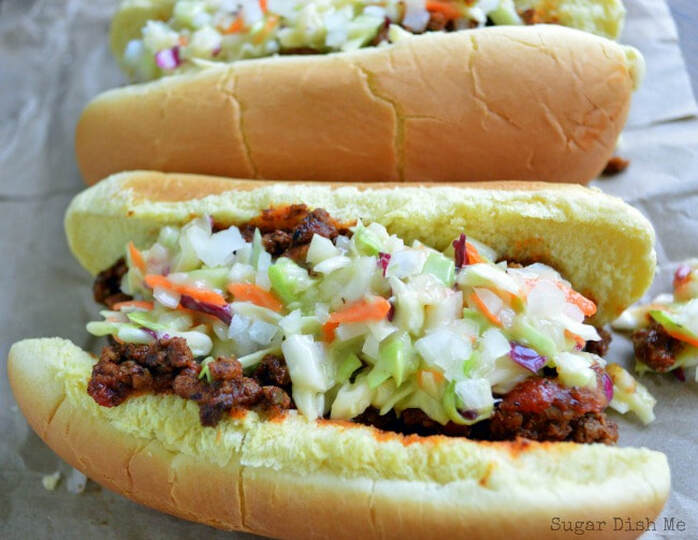
The little town up the road was wonderful as well. Every shop and street were always dressed up for the races. Checkered flags abounded and signs welcoming race fans were everywhere.

The people were friendly, and the businesses were fair. There was no price gouging in North Wilkesboro. When I said that they rolled out the red carpet for the fans, I really meant it. Those good people knew that the race fans were the backbone of their economy, and we were treated like royalty, in the tradition of true Southern hospitality. On a race weekend, you would find sing-alongs in the restaurants (Follow the bouncing ball) and tailgate parties in the motel parking lots. More than likely, you’d meet some of the drivers there as well as lots of other race fans. Junior Johnson himself described it very well when he said, “It was like a big fair, or like Disney World. Everyone loved North Wilkesboro.”
The next year when we went back, we inadvertently discovered one of the local tricks for exiting the track after the race. I noticed a few cars turning away from the direction of the main gates and driving toward the back of the field that served as a parking lot. On a whim, I cranked the wheel on my T-Bird left and followed them to where they headed down a lane that was no more than a couple wagon wheel ruts. It was bumpy and the going was slow, but “What the heck?” We were in no hurry, and someone up there must know where the path ended.

It ended in a farmer’s driveway, and several children were there to greet us, each one armed with a mason jar. As each car passed, the driver would deposit folding money in a mason jar, and the children thanked us and wished us well. The funny thing was, no one minded, and many of those bills were of fairly large denomination without a Washington among them. We were away from the track at least an hour earlier than we would have been. The kids were happy and so were we. You can be sure that we used the wagon trail from then on. We returned to North Wilkesboro several more times before racing “outgrew” one of the oldest and best tracks on the circuit.

How, exactly, does a sport outgrow its roots? Well, in this case, I’d have to say that greed and stubbornness played a large part. As time wore on, Enoch Staley passed away, leaving his half-interest in the old track to his son Mike. Charlie Combs, who owned the other half of the track, also left us, leaving his half-interest to his brother Jack. In August of 1995, Bruton Smith purchased a one-half-interest in North Wilkesboro from Jack Combs, for a reported $6 million and without hesitation, took the NASCAR date from the historical track for his new Texas Motor Speedway.
Smith also sought to purchase the remaining half-interest from the Staley family, but they never came to an agreement. Staley stated that not only was Smith’s offer $2 million less than he could get elsewhere, but that Smith wanted to pay for it with Speedway Motorsports, Inc. stock, which couldn’t be sold for three years. “It was not a good offer. We all looked at it and just walked away shaking our heads,” Mike Staley said. The Staley family sold its half to Bob Bahre for $8 million in December 1995. Bahre took North Wilkesboro’s other NASCAR date to New Hampshire International Speedway, which he owned at the time.
When Bahre purchased his half of the track, it was with a promise to the Staley family that he would not sell it to Smith in the future, and he kept his promise… for the time being anyway. Bahre claimed that despite taking a date away for New Hampshire, it was his desire to keep North Wilkesboro operating, and he hoped for a new race date from NASCAR. Smith also said that he wanted to keep the track open, but he wanted no part of being only half owner, citing his fear that the day-to-day operations would all fall to his company, Speedway Motorsports, Inc. Despite having millions of dollars tied up in North Wilkesboro, neither of those bullheaded tycoons would sell out to the other and neither wanted to be a partner of the other in any business venture.
“I think someday someone will have a race there,” Bahre said. “But it’s probably going to be after Bruton and I are in heaven or hell.”
[Comments withheld as to which that would most likely be]

It should be noted here before continuing that NASCAR was not obliged to allow the transfer of either date to another track. Bill France Jr. however, quietly looked the other way and let the rich men have their way, assuming, and probably correctly, that there were more folks living in Ft. Worth and New England than in North Wilkesboro, NC. “The All-American Sport”, which always claimed to be all about the fans, was already leaning more and more toward that almighty dollar and less toward the fans that spent that dollar.
With that stalemate in place, North Wilkesboro saw its last race on September 29, 1996 and Jeff Gordon became the last Winston Cup driver to take the checkers there. As one might expect, the effect on that little town was devastating. As the track sat and decayed, local businesses that had grown up around it withered or died altogether, especially those in the hospitality industry. At least three attempts have been made since to revive the old track to some degree, but due to a combination of underfunding and/or poor management, all have failed. Today, a drive past her evokes only sad memories of what used to be, coupled with little hope that it will ever be again.
With the growth of stock car racing over the intervening years, it seems improbable that a track that seats only 40,000 will ever see another Cup race, and while there was once some talk of North Wilkesboro being home to either the Xfinity or Camping World Truck series, those thoughts have faded and died much like the track herself. Junior Johnson, once rumored to be interested in buying the track himself, has grown old and retired to another area of North Carolina, leaving Ingle Hollow behind. The picture below, taken by an unknown (to me) photographer, is perhaps the saddest picture this weathered old fan has ever seen. Junior, all alone, surveying the remains of “His house.”
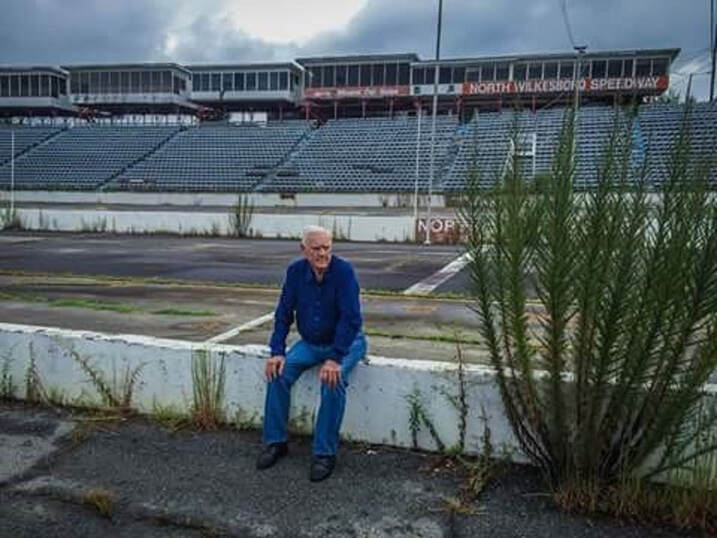
I’ve gathered several other pictures, showing the decay and destruction of man-made things as Mother Nature reaches out to reclaim what she once called her own.

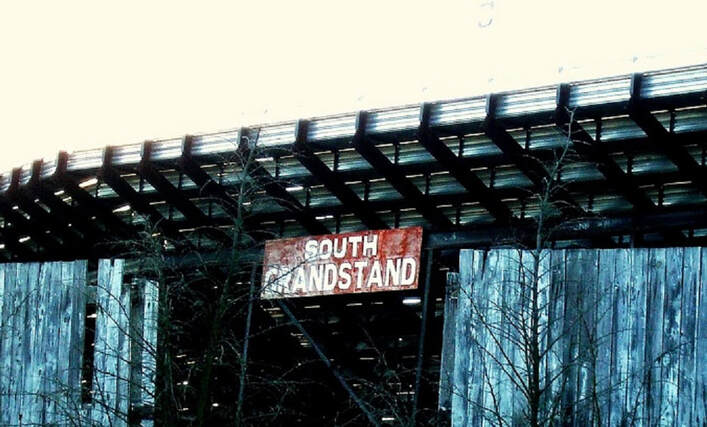
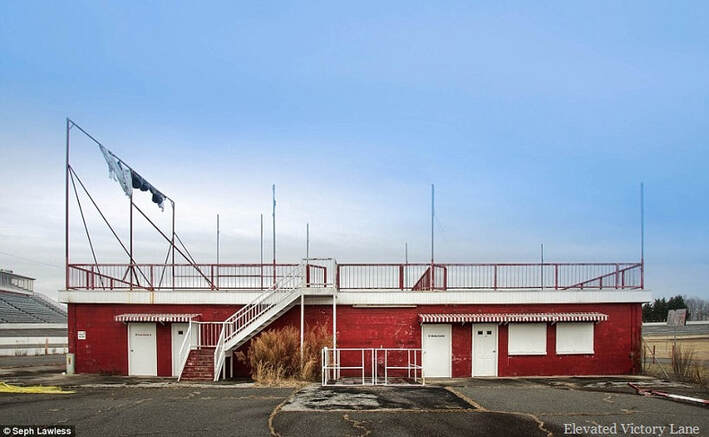
As for the friendly little town, the “little piece of heaven” I was told about all those years ago, it turned instead into an economic hell. From stats circa 2010, North Wilkesboro and surrounding Wilkes County were carrying an astronomical unemployment rate, but stats I found for circa 2016 indicate that has become somewhat better. I suspect much of that can be accredited to folks giving up and moving away to where there is employment.
After analyzing Census data from the 2010-2014 American Community Survey for the 319 places in North Carolina with more than 2,000 people, we were left with this set of the ten poorest places in the Tar Heel State:
1. Enfield 2. Yanceyville 3. Elizabeth *4. North Wilkesboro 5. Roxboro 6. Boone 7. Maxton 8. Fairmont 9. Edenton 10. Plymouth
The link takes you to the site that conducted the study. It tells us that the factors contributing to the findings were:
- Poverty Level
- Median Household Income (Lower is poorer)
- Unemployment Rate (Higher is poorer)
Fourth poorest out of 319 places just in the state of North Carolina gives a fair picture of the fact that North Wilkesboro and Wilkes County have not recovered from the loss of the track on which their once-thriving economy depended almost entirely. The area has “adjusted.” There is no visible way to recover.
Author’s note: The stats above are from 2016. The link has been updated to 2021 and I’m happy to report that North Wilkesboro is nowhere to be found on it now. As stated above, those that couldn’t find employment there have moved on to where they could gainfully sustain themselves and their families. It hasn’t really gotten better, it’s just different now with far less residents than in better times.
Before those cards and letters start coming in, I understand that it’s “Progress.” I’ve heard the reasoning and can even agree with some of it… to a degree. Chalk it up to my age, but for me, it’s just heartbreaking to see a place where we shared in so much fun, standing deserted and alone as time and erosion continue to take over.
Before we part company today, I have chosen two short videos for your viewing pleasure. The first is a one shot without comments, using a guided drone with a camera aboard. You’ll recognize many spots from the still shots. The red building outside the track in turn 4 is (was) the ticket booth. As the film shows, the roof has suffered major damage and fallen into a large portion of the building. The other red building, inside the track, was the “elevated” Victory Lane, where the winning car was lifted to the top of the building to carry out the celebration of having won at North Wilkesboro. It was very impressive!
The final video for today is quite short and presents an aerial look at the track before so much damage had occurred, with a voice override in which you will recognize many of the names and voices you will hear. The title accompanying this one reads merely “Ghosts.”
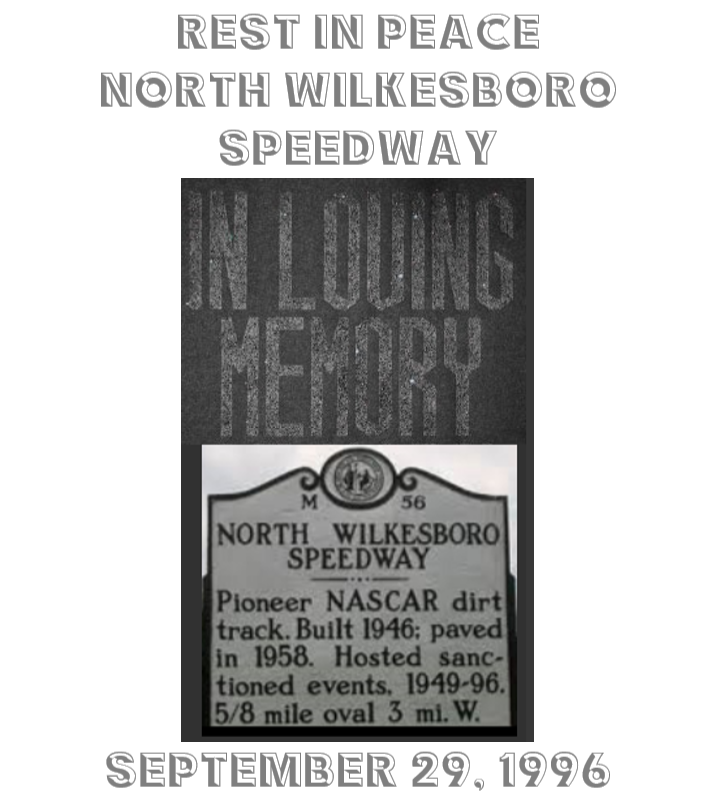
Be well gentle readers, and remember to keep smiling. It looks so good on you!
~PattyKay

(Editor’s note: This story is publish with the permission from the author! It was originally published on RaceFansForever; )



Loved it then, love it now. Thank you, Mama
BTW, I still can’t imagine cole slow on any hot dog, especially with chilli.
Then you haven’t lived and have NO adventure in your soul! You’ve always been a picky eater, and you know I’ll eat anything that can’t outrun me. So be it. LOL
Always hopes to make it there and thought I would get a chance but didn’t see the handwriting on the wall and missed it. Never heard anyone who went talk bad about her.
I’d love to see her come back. The strong talk for it though just points to the state of the sport today. Her dates went to bigger facilities where more fans could attend and more money could be made. There was a time when we couldn’t go back. Today, the sport has contracted to where such size facilities are feasible. Not sure which makes me sadder.
Thanks for the article. I needed that.